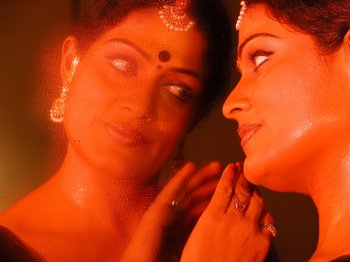
|
 |

|
 |
Anish Kapoor: Bharatanatyam artist? - Geeta Chandran, Delhi e-mail: geetachandran@gmail.com January 6, 2011 (Dancer Geeta Chandran reacts with rasa at Anish Kapoor's Delhi show at NGMA. This article was published in the Asian Age dated December 27, 2010) His larger than life metallic and other media installations seem at first spotting so far removed from the intricate world of classical Bharatanatyam, but on deeper analysis there is a kindred spirit that binds Anish to Bharatanatayam. Bharatanatyam is an art that blossoms through the eyes of the viewer. It is the private moment when the viewer binds with the dance that rasa is created. The dance is not to be "viewed" in the sense of an object. It has to be engaged with; the best viewer is one whose sensibilities are stoked by the dance. And in that moment of emotional bonding, the dancer, the dance and the viewer become synergized into a single creative energy flow. This is in essence what our rasa theory is all about. And it is precisely this engagement with the viewer that Kapoor's installations seek. The metallic and other multi-medium works are not just to be viewed but to be engaged with by the viewer to reveal deeper thoughts - and even truths - that lie dormant within ourselves. Take Vertigo. By capturing reflections of the viewer, the sculpture gets energized by the personality of who is viewing. And then the sculpture reacts by playing with "opticality" and stretching, as it were, our imagination of ourselves. Thus our own self-perceptions get altered as we slowly engage with Kapoor's work from different vantage points. This is the key strategy that the dance too employs. By engaging with human emotions that resonate of personal memory or of collective emotion, the dance becomes integrated with the viewer's soul. This personal narrative of the viewer is what brings both arts alive. It is the individual's level of commitment to partaking of the art that defines what both means to them. The viewer thus ceases to be passive and is converted into a protagonist in the engagement with the art-moment.  That Anish and Bharatanatyam seem so different are obvious. Of course! Classical dance with its strict grammar and pristine rules and its rather narrow alley of what is permissible seems devoid of the creative freedom abandon that Anish seems to enjoy. But wait. On closer examination, Anish too has had to evolve his own grammar code driven by his architectural leanings and his respect of the malleability of his materials. And just like the dancer tames the body-instrument to make it a vessel to be imbued by the viewer's sensitivities and sensibilities, Anish too has had to tame metal, wax, plaster and stone and imbibe cold elements with the ability to be cloaked with our live and felt emotions. So while Bharatanatyam's grammar came to me as an inherited legacy from giant gurus, Anish's grammar is the result of his own strivings. But the key point I wish to emphasize is that the both grammars - whether collective or individualistic - succeed only when they touch the viewer and push their emotions to new frontiers. Both Anish and the dance are carriers of colour. How saturated a pigment Anish employs. The reddest of reds and the yellow-est of yellows! Celebrating life and nature without a whit of apology! Does not the dance do the same? Celebrate textile, ornament and colour with the same abandon? The other true link is that both belong to the public domain. One cannot own Bharatanatyam just as an Anish installation cannot be purchased. Both revel in open realms where one and all can engage with them. Thus the democratic impulse of both is another syncretic point of convergence. So what did you feel? Did you feel a moment of shringara/affection when you saw your reflection in Vertigo? Or hasya/humour as features was altered? Or bheebatsa/disgust at what you did not like in yourself ? Or karuna/pathos at some memory of your past physicality being revealed? Or roudra/anger at being rudely morphed without permission? Or bhaya/fear at what you do not wish your body to be? Or veera/heroic at the ability of your image to be ever changing? Or adbhuta/wonder at the ability of the one self to instantly become the so many? Or shanta/peaceful at the quiet understanding of the inherent potential of the human body to undergo multiple transformations in a single instant? What else connects Bharatanatyam to Anish is that they both have to be experienced alone. As just individuals. And get reacted to as individuals. So while being wholly public and in the open, they celebrate the cult of the individual and propel the solo to take flights far into the beyond. Would you dare? Bharatanatyam dancer Geeta Chandran is the founder president of Natya Vriksha, New Delhi. |